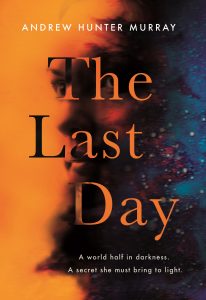THE LAST DAY by Andrew Hunter Murray – THE UNSEEN ACADEMIC

This is an occasional series of posts drawing on my excursion into the academic side of creative writing. Having taken a career break from secondary schooling to further my own education with some post graduate study I’ve completed an MA in Creative Writing at Queen’s University Belfast. I’ve now started on a PhD project at the same university with the catchy title “Navigating the mystery of future geographies in climate change fiction.”
So the Hive has kindly given me space to post reviews of climate fiction books as well as blogging thoughts and articles on other aspects of my PhD experience.
This week I’m going to look at The Last Day by Andrew Murray Hunter
 The Last Day isn’t strictly a climate change novel, in that the global change that has made a dystopia of the near future owes nothing to fossil fuel consumption and associated atmospheric warming. However, it shares many features with John Lanchester’s The Wall and Emmi Itaranta’s Memory of Water in that the change has ushered in authoritarian regimes. The world is disconnected with but still haunted by its past amid conflict over resources and refugees.
The Last Day isn’t strictly a climate change novel, in that the global change that has made a dystopia of the near future owes nothing to fossil fuel consumption and associated atmospheric warming. However, it shares many features with John Lanchester’s The Wall and Emmi Itaranta’s Memory of Water in that the change has ushered in authoritarian regimes. The world is disconnected with but still haunted by its past amid conflict over resources and refugees.
Murray’s different plot engine serves to highlight how it is the imagined outcomes rather than its mechanisms that have made a muse of climate change for many authors. The apocalyptic visions of mid-twentieth century writers like Nevil Shute’s nuclear winter On The Beach, or John Wyndham’s shattered worlds in The Day of the Triffids or The Kraken Wakes have found new impetus in climate fiction.
Murray’s plot conceit lies in the concept of The Slow (and ultimately The Stop). A cosmic disaster has caused the rotation of the Earth to slow to a final irrevocable stop over the course of the decade between 2020 and 2030. It’s not an exact stop in that the Earth’s period of rotation matches its period of orbit so that one side of the Earth is locked always facing the Sun, the other faces away into the cold void of space. (Much as the tidally locked Moon slowly rotates as it orbits the earth to shyly keep its dark side always facing away from us.) The drawn out slowing of the Earth, like some agonising wheel of fortune, picks winners and losers as the Britain of Murray’s imagination crawls through a final six month night before thankfully emerging into the heat of a perpetual late morning (around 11.00 am by my reckoning) on the everlasting last day.
The story, set some thirty years after The Stop follows Ellen Hopper, a scientist aboard a rusting oil rig type outpost somewhere in the region of the Scilly Isles. Her mundane work involves studying currents and watching for anything that might drift across the Atlantic from where the East coast of America lies condemned to a stalled and frozen pre-dawn. In one of the many parallels between The Wall and The Last Day I found it ironic that Murray’s story begins more or less at a location where Lanchester’s ends. A contact from Hopper’s old college professor drags her back to London revisiting her past as she weaves her way through elements of mystery and political thriller to try and understand what a dying man wanted to tell her.
The unspinning Earth is a fertile ground for speculative fiction. The greatest extremes in temperature in the solar system, are to be found between the hot (430 oC) and the cold (-180 oc) sides of Mercury as it orbits the Sun, (almost) as locked in its rotation as Murray imagines his future Earth. Arthur C Clarke deduced logically enough, that there must be a region on Mercury along the border between its day and night that was at a habitable temperature and NASA has found evidence of ice at Mercury’s poles. Venus, almost equally slow spinning manages to be even hotter than Mercury and more uniformly heated with the fast-moving winds of its thick atmosphere distributing heat across its inhospitable (462 oC) surface.
Murray’s near future Earth – with a thinner atmosphere than Venus – lies somewhere between the Mercurial and Venusian experience two with a frozen darkside to the Earth and a large hot zone in the centre of the daylight side. This triggers two successive waves of refugees, the first from the frozen cold side and then years later a second surge from the sudden collapse of attempts to maintain life in the Hotzone stretching from Africa North to the Mediterranean and East towards India. As with The Wall, the political response to these successive waves of refugees is a key driver of Murray’s plot. However, where Lanchester keeps to a grunt’s eye view of the situation, Murray is focussed on the venality of named politicians given power in adverse circumstances.
An accident of geography – of latitude and longitude has made Northern Europe the last habitable place on Earth with its southern limits, stretching through France towards Italy turned into a vital breadbasket where slave labour works to capitalise on the perpetual sunshine by bringing in five harvests a year. Richard Davenport, first the saviour then effectively dictator of Britain has created a new Angevin Empire with France under his rule and a vestigial enclave of refugee Americans granted an independent concession in the southern counties (though frustratingly he never narrows it down to SE or SW?). The first wave of refugees from the cold side were repelled with a barrier of sunken ships sealing up the channel (a motif that doesn’t bear too rigorous scrutiny). The second wave from the collapsing hotzone were deliberately sunk in an inverted Dunkirk story, with a future Admiral Ramsey shelling rather than shepherding the flotilla of small (and large) boats as they crossed the channel. In its depiction of rampant British exceptionalism, jingoistically rejuvenated empire building, meekly subservient press reporting, hostility towards refugees and yet ridden with governmental corruption and incompetence, Murray’s 2020 book is certainly a novel of its time. Themes shares with Lanchester’s The Wall.
Murray’s Britain is a brutal place with Orwellian police forces. A scene of convicts marched through the streets en-route to slave labour in the breadbasket harshly is reminiscent of tales of columns of Jews as work parties being driven through the streets of Nazi Germany, even to the point where Hopper is beaten unconscious by the police for trying to help one who has collapsed from fatigue.
Ultimately though, Murray’s characters and plot to do not live up to the ambition of his setting. Even the incredible alien nature of a world with the Sun poised forever just shy of noon is dissipated as Murray sticks to the nomenclature of day and night, morning and evening. It transpires that this stems from dictator Davenport’s imposition of a curfew so as to recreate a sense of day and night with shuttered windows and blackouts for the convenience of his police force. However, it also suits the convenience of the plot, with Hopper’s investigation divided into conventional days and nights that dampen the essential unfamiliarity of Murray’s world, much as the artificial gravity so beloved by the ships of space opera deprive us of the narrative opportunities of weightlessness.
In so far as this is a mystery, Hopper is an amateur sleuth, a trope which has always required either ignorance or incompetence on the part of the conventional authorities. Certainly, the dark forces chasing Hopper through the always sunlit streets of London do seem rather inept. Not only do they go on a lunchbreak in the middle of searching a house leaving one room very clearly “half searched” but they also take with them the police officer who has been standing guard outside the house enabling Hopper to go in and find the one thing these experts missed. The plot is littered with moments of absurd serendipity as Hopper evades capture with the aid of sympathetic policeman, randomly opened doors and well-connected friends and relatives whose lives are swiftly ruined by her blundering investigation. The moments of peril have a uniformity of being raised and then swiftly resolved in a way that feels monotonal rather than a racking up of narrative tension. The past and present mysteries – why she fell out with her mentor and what information he now wants to convey to her don’t feel as earth shattering as they should. The spectacular convenience with which Hopper finds things from hidden transmit and receive radios to paper reports is just a bit wearying. The truth falls into her hands-on pieces of paper (for this future world with its food shortages still clings to hard copy bureaucracy rather than electronic records). Hopper’s own motivation is illogically fluid, sliding for no clearly discernible reason from defiant refusal into zealous engagement in the mission she has been called to.
There were lines that made me smile.
Ellen is a rarer child born during the baby bust years of the Slow.
“The chaos and shortages at the end of the Slow had kept the planet’s libido in check… Many pregnancies had been brought to an end, prematurely and inexactly.”
Echoing Lanchester and others in the notion a failing world is not one to bring children into.
There were also some points of resonant political observation
“Everyone says they’re opposite endeavours, politics and science; that one deals with truth and the other with perception.”
“If Richard (Davenport) can persuade enough people their self-interest is best maintained by living in the world he’s built, he’ll stay. But there are two ways of doing that. To persuade them their world is bright and good – that’s the first. But to persuade them the alternative is catastrophe – that’s even more powerful.”
The refugee policy critique is strong
“The country was on the brink of collapse. Right on the brink. For six months it seemed probable we would be totally overrun. What do you do if you’re in a full lifeboat and there are thousands more in the water?”
“It wasn’t a lifeboat. It’s a country. We could have taken more people.”
The characters also echo Hobbes’ Leviathan, the notion that any order – however tyrannical – is preferable to chaos.
“A dictatorship is better than a wasteland.”
Murray has Hopper and her allies reject this mantra and strive to shine a light of truth that may yet bring down a government – in the best traditions of political thrillers, be they contemporary or futuristic.
However, the story’s impact was eroded for me by immersion breaking flaws in its verisimilitude. Besides the bad guys’ incompetence and Hopper’s frequent good fortune, there were issues like the prevalence of cigarettes – in a world struggling to grow food yet happy to farm tobacco? Satellites are launched all the way into orbit from temporary stations on the ground, and once injected into orbit, their course can be corrected from the ground? How? Notwithstanding that Murray makes a point of acknowledging the science specific advice he had received, there were just too many aspects that seemed deeply flawed to me. The central notion of a passing unnoticed white dwarf star arresting a planet’s spin is absurd to my mind, but I was happy enough to suspend my disbelief in order to establish the central conceit of this world. The subsequent scientific and plot liberties are not so easily excused, and left me disappointed in a tale that did not live up to the its initial leap of imagination.

